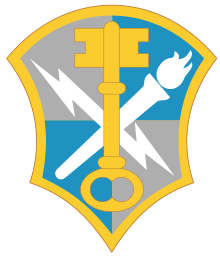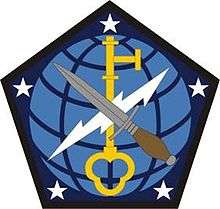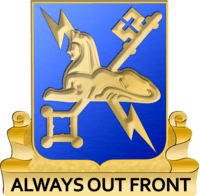Military Intelligence Corps (United States Army)
| Military Intelligence Corps | |
|---|---|
|
Regimental Insignia | |
| Country | United States |
| Branch | U.S. Army |
| Type | Military intelligence |
| Garrison/HQ | INSCOM – Fort Belvoir, VA |
| Motto(s) | Always Out Front |
| March | "Freedom on Parade" |
| Engagements |
American Civil War World War I World War II Korean War Vietnam War Operation Desert Storm Operation Enduring Freedom Operation Iraqi Freedom |
| Commanders | |
| Current commander | BG Nathan Fletcher |
| Deputy Chief of Staff, Intelligence | LTG Mary A. Legere |
| Insignia | |
| Branch Insignia |
 |
The Military Intelligence Corps (sometimes referred to as MI) is the intelligence branch of the United States Army. The primary mission of military intelligence in the United States Army is to provide timely, relevant, accurate, and synchronized intelligence and electronic warfare support to tactical, operational and strategic-level commanders. The Army’s intelligence components produce intelligence both for Army use and for sharing across the national intelligence community.[1]
Structure
Approximately 28,000 military personnel and 3,800 civilian personnel are assigned to intelligence duties, comprising the Military Intelligence Corps. Some of the key components include:
- Office of the Deputy Chief of Staff, Intelligence (G-2). As the Army's Chief Intelligence Officer, the responsibilities of the Deputy Chief of Staff for Intelligence include policy formulation, planning, programming, budgeting, management, staff supervision, evaluation, and oversight for intelligence activities, as well as overall coordination of the major intelligence disciplines. The current G-2 is Mary A. Legere.
 Army Intelligence Seal |
- United States Army Intelligence and Security Command (INSCOM), located at Fort Belvoir, Virginia. It is the Army's major intelligence command.
 INSCOM Emblem |
 INSCOM Shoulder Sleeve Insignia (SSI) |
- United States Army Military Intelligence Readiness Command (MIRC), located at Fort Belvoir, Virginia. It is the Army Reserve's intelligence command.
 MIRC SSI |
- United States Army Intelligence Center of Excellence (USAICoE), located at Fort Huachuca, Arizona. It is the Army's school for professional training of military intelligence personnel.
 USAICoE SSI |
History
Intelligence personnel were a part of the Continental Army from its founding in 1775.
In January 1863, Major General Joseph Hooker established the Bureau of Military Information for the Union Army during the Civil War, headed by George H. Sharpe. Allan Pinkerton and Lafayette C. Baker handled similar operations for their respective regional commanders. All of those operations were shut down at the end of the Civil War in 1865.[2]
In 1885, the Army established the Military Intelligence Division (MID). In 1903, the MID was placed under the new general staff in an elevated position.[3]
In March 1942, the Military Intelligence Division was reorganized as the Military Intelligence Service (MIS). Originally consisting of just 26 people, 16 of them officers, it was quickly expanded to include 342 officers and 1,000 enlisted personnel and civilians. It was tasked with collecting, analyzing, and disseminating intelligence. Initially it included:
- an Administrative Group
- an Intelligence Group
- a Counter-intelligence Group
- an Operations Group
In May 1942, Alfred McCormack established the Special Branch of MIS, which specialized in COMINT.
On January 1, 1942, the U.S. Army Corps of Intelligence Police (CIP), founded in World War I, was re-designated as the US Army Counter Intelligence Corps (CIC). In 1945, the Special Branch became the Army Security Agency.
On 1 July 1962, the Army Intelligence and Security Branch was established as a basic Army branch to meet the increased need for national and tactical intelligence.[4]
It was in July 1967, that a number of intelligence and security organizations were combined to form the military intelligence branch.[5][6][7] In 1977 they eventually recombined with the Army Intelligence Agency and Army Security Agency to become the US Army Intelligence and Security Command.
Military Intelligence Corps
The Military Intelligence Corps is one of the basic branches of the United States Army. In 1971, the United States Army Intelligence Center was established at Fort Huachuca, Arizona as the home of the military intelligence branch. On 1 July 1987 the Military Intelligence Corps was activated as a regiment under the U.S. Army Regimental System.[8] All United States Army Military Intelligence personnel are members of the Military Intelligence Corps.
Major Military Intelligence Brigades/Units
| Name | Insignia | Supports | Garrison |
|---|---|---|---|
58th Expeditionary Military Intelligence Brigade
|
 |
Maryland Army National Guard | Maryland |
66th Military Intelligence Brigade
|
 |
United States Army Europe | Lucius D. Clay Kaserne (Wiesbaden, Germany) |
71st Expeditionary Military Intelligence Brigade
|
 |
Texas Army National Guard | Texas |
111th Military Intelligence Brigade
|
 |
United States Army Intelligence Center of Excellence | Fort Huachuca |
116th Military Intelligence Brigade[9]
|
 |
INSCOM | Fort Gordon |
201st Expeditionary Military Intelligence Brigade
|
 |
I Corps | Fort Lewis |
300th Military Intelligence Brigade (Army National Guard)
|
 |
INSCOM | Draper, Utah |
470th Military Intelligence Brigade
|
 |
United States Army South | Fort Sam Houston |
500th Military Intelligence Brigade
|
 |
United States Army Pacific | Schofield Barracks |
501st Military Intelligence Brigade
|
 |
Eighth United States Army | Yongsan Garrison, (South Korea) |
504th Military Intelligence Brigade
|
 |
III Corps | Fort Hood |
505th Military Intelligence Brigade (Army Reserve)[10]
|
 |
MIRC United States Army North |
San Antonio, Texas |
513th Military Intelligence Brigade
|
 |
United States Army Central | Fort Gordon |
525th Expeditionary Military Intelligence Brigade
|
 |
XVIII Corps | Fort Bragg |
| 650th Military Intelligence Group[11][12] |  |
Supreme Headquarters Allied Powers Europe | Mons, Belgium |
704th Military Intelligence Brigade
|
 |
National Security Agency | Fort George G. Meade |
706th Military Intelligence Group
|
 |
Central Security Service | Fort Gordon |
780th Military Intelligence Brigade
|
 |
United States Army Cyber Command | Fort George G. Meade |
902d Military Intelligence Group
|
 |
INSCOM | Fort George G. Meade |
| National Ground Intelligence Center |  |
INSCOM | Charlottesville, Virginia |
Creed of the Military Intelligence Corps
I am a Soldier first, but an intelligence professional second to none.
With pride in my heritage, but focused on the future,
Performing the first task of an Army:
To find, know, and never lose the enemy.
With a sense of urgency and of tenacity, professional and physical fitness,
and above all, INTEGRITY, for in truth lies victory.
Always at silent war, while ready for a shooting war,
The silent warrior of the ARMY team.
Military Intellegence Corps March
Onward to victory!
Our silent soldiers to the fight.
Onward to victory!
Trained and ready day or night.
Peace through intelligence!
Here's to your health and to our corps.
Strength through intelligence!
Toujours Avant forever more.
Museum
The United States Army Intelligence Museum is located at Fort Huachuca, Arizona. It features the history of American military intelligence from the Revolutionary War to present.
Military Intelligence Hall of Fame
See also
- G-2 (intelligence)
- Combat Support
- Company Level Intelligence Cell
- Military Intelligence Corps careers
- United States Army Counterintelligence
- Twenty-Fifth Air Force - Air Force Intelligence
- Office of Naval Intelligence
References
- ↑ United States Intelligence Community Official Website Archived 21 October 2007 at the Wayback Machine.
- ↑ "Archived copy" (PDF). Archived from the original (PDF) on 25 December 2013. Retrieved 2014-07-24.
- ↑ The FBI: A Comprehensive Reference Guide. Google Books. Retrieved 20 May 2011.
- ↑ "Army Birthdays". U.S. Army Center of Military History. Department of the Army. Retrieved 3 September 2015.
- ↑ "Publications 101" (PDF). usapa.army.mil.
- ↑ "index2". Hrc.army.mil. 28 October 2009. Retrieved 20 May 2011.
- ↑ John Patrick Finnegan, Center of Military History, United States Army, Washington, D. C. (1998). "Military Intelligence". Archived from the original on 22 January 2008. Retrieved 18 February 2008.
- ↑ Welcome To the Intelligence Center Online Network Archived 17 July 2007 at the Wayback Machine.
- ↑ Capt. Michael Pederson (116th MIB) (3 December 2014). "DCGS-A provides foundation for aerial intelligence". army.mil. Retrieved 13 December 2014.
- ↑ MIRC Family Programs Newsletter; Volume 1, Issue 4 Archived 18 April 2015 at the Wayback Machine. dated October 2014, last accessed 18 April 2015
- ↑ AR 381–10, U.S. Army Intelligence Activities, Department of the Army, dated 3 May 2007, last accessed 7 July 2012
- ↑ FM 34-37; Strategic, Departmental, and Operational IEW Operations; Chapter 9, 650TH Military Intelligence Group, last accessed 7 July 2012
- ↑ "G-2 Intelligence". U.S. Army Europe. Retrieved 25 November 2016.
Further reading
- McChristian, General Joseph A. (1994). The Role of Military Intelligence, 1965–1967. Vietnam Studies. United States Army Center of Military History (reprint of 1974). CMH Pub 90-19.
- Ruiz, Victor H., 2010. "A Knowledge Taxonomy for Army Intelligence Training: An Assessment of the Military Intelligence Basic Officer Leaders Course Using Lundvall’s Knowledge Taxonomy" . Applied Research Projects. Texas State University Paper 331.

